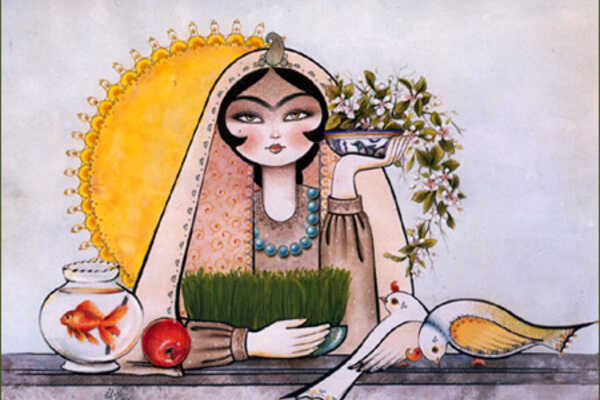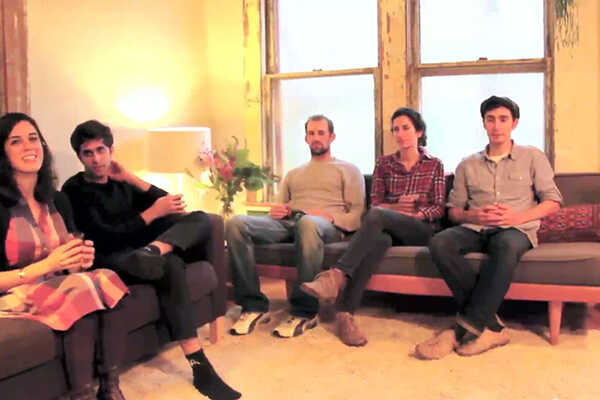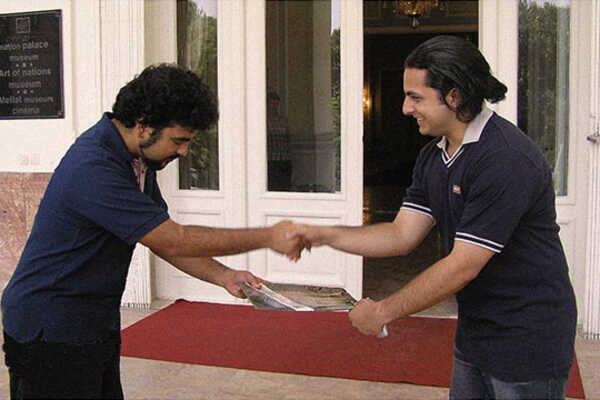
Complete Guide to Living Your Best Nowruz
(updated from February 20th, 2023):
I wrote the following update a few months after the murder of Mahsa Amini. This year, there is a different darkness on the world as we've been experiencing over a year of blatant genocide in Gaza. And the situation for women in Iran has not improved. Still, the note that I wrote below still rings true).
(updated from February 17th, 2020):
This article was written just before the pandemic shut everything down in March 2020- little did I know that nowruz would be very, very different that year. Everything was shut down, everything had slowed down, and because there was less interference from us (less cars in the streets, less noise, less movement), in some ways, it felt like more of a spring than ever. Nature was given a chance to really shine and spring emerged with tenacity and fervor- the flowers bloomed, the sky turned bright blue, and birds chirped beautifully.
Similarly, this year's nowruz is a particularly different ones for Iranians, both in Iran and throughout the world. We are now a few months after the death of Mahsa Amini and the spark of a revolution, and there is a darkness and heaviness that we all are carrying with the continuing brutal crackdowns from the Islamic Republic. But despite all this- spring is coming. And with it comes the rituals and traditions we've been carrying and honoring for thousands of years, despite any external factors that might have been in the way. No matter what, spring is coming- nature is unstoppable, and so is the hope that spring and the rituals and traditions of nowruz bring.)
First things first- March 20, 2025 marks the first day of spring in the northern hemisphere, and the first day of the new year in the Persian calendar, our biggest holiday also known as nowruz (also spelled Norooz, Nowrooz, Noruz). Even though Iranians are spread out all over the world in different countries, with different ethnic backgrounds, religious beliefs and political tendencies, this holiday unites us all! In fact, even Iranians in the southern hemisphere, where spring is nowhere in sight for the coming months, join the rest of us by welcoming new beginnings and new life. Tracing back to Zoroastrian times, nowruz has persisted and resisted through the millenia, and I like to think that this is because it strikes at a truth deep within the soul of the earth- that the beginning of spring is time for all forms of life to come together and rejoice in peace and harmony!
There are many, many moving parts to this boisterous holiday. To help you prepare and live your best nowruz, we’ve put together this thorough and comprehensive guide. Feel free to take from it what you will and leave the rest alone. And you can celebrate this holiday no matter your ethnicity or religious background!
Before we begin, a few quick notes:
- Nowruz means ‘new day’ in Persian, and is the name of the holiday.
- This year, nowruz occurs on March 20th, 2025, at 5:01 am central time in the United States- but it occurs at this exact precise moment everywhere on earth. It is the moment that earth passes the vernal equinox.
- The nowruz holiday lasts 13 days.
- Nowruz marks the first day of the Persian calendar. This year, we will be entering the year 1404.
- Nowruz is a secular holiday, and is practiced not only in Iran, but in other countries associated with the wide spread Persian empire, such as Afghanistan, Tajikistan, Georgia, etc. and by Iranian populations living outside of Iran as well.
Note: You can follow along on Instagram to see updates on how I'm personally preparing for nowruz, using the following guidelines!
So now, without further ado, let’s learn how to prepare for and celebrate nowruz!

One month before- CLEAN ALL THE THINGS!
(Start February 20th, 2025)
February 20th of this year (2025) is the first day of the month of esfand on the Persian calendar- the last month of the year!
This month corresponds to Pisces in the zodiac (did you know the Persian months correspond with the zodiac? That’s one of the benefits of having a calendar system based on the seasons and the stars!).
For those of you that don’t know, esfand is the name of the incense that is burned in Persian culture to get rid of the 'evil eye.' Iranians, even the ones who claim to be very intellectual and scientific, tend to be fairly superstitious. The practice of burning esfand to ward off the evil eye can be traced to Zoroastrian times, and is still a common practice for Iranians today. How is it used? For instance, if someone is jealous of your family, or even if they are unintentionally over complimentary, they could be in danger of ‘jinxing’ the family. This is called cheshm khordan, literally ‘struck by the eye’. The antidote to cheshm khordan is to burn esfand and do a prayer- as the esfand crackles and burns, it emits a smoky incense that wards off any ill intentions. Esfand can also be used as sage is used in the west to rid a place of negative energy.
So back to ‘cleaning’- the month of esfand is the perfect time to partake in the ritual of khooné takoonee- literally, shaking of the house. With this nowruz tradition, you are supposed to clean the entire house, but not in a cursory, surface way. As the name suggests, you need to turn that entire house upside down to clean every nook and cranny. This includes going through all of your possessions and getting rid of (or donating!) anything that is outdated, old, and raggedy. Every shelf needs to be dusted, every baseboard needs to be vacuumed, all the filters need to be changed- this is time to let the sunshine and air into every dark and dank corner of your home- refresh and begin anew! By the time nowruz begins, you’ll have a nice, fresh and clean house with which to start the new season.
And this is why I like to make a list at the “beginning of the month” (in our case, February 20th, 2025), and GO FOR IT! And during the process, I burn some esfand to rid the place of any negative or stale energy!
Speaking of which- khooné takonee doesn't have to be limited to the physical world- it can also very much refer to internal matters as well. Just as you need to get rid of clutter and dusty corners in your house, you need to get rid of clutter and dusty corners in your heart and mind as well. Many of the rituals of nowruz help us to do this- we'll get into those later.

3 weeks before- Prepare your lebāsé nō (new clothing), from head to toe!
(Start February 27th, 2025)
While you are cleaning, it’s also a great time to go through your closet and rid it of any clothing that no longer fits or is in bad shape. For nowruz, everyone in the household, from the little baby to the grandmother, must be wearing a completely new outfit (this includes socks and underwear!). Although I love second hand shopping, for nowruz I like the symbolism that comes with purchasing brand new clothing that's being worn for the first time. However, in keeping with the nowruz spirit, a time to celebrate mother nature, I make sure the new clothing is ethically produced using natural materials. And although it’s nice to have your nowruz outfit prepared in advance, you absolutely cannot wear it until the moment of new year!

2 weeks before- Start planting your sabzé
(Start March 7, 2025)
One of the most important parts of the nowruz table is the sabzé- sprouts grown a couple weeks before. The sabzé is used as the centerpiece of the table, and represents new growth, life, and good health. Anyone can grow their own sabzé from a variety of different types of beans (mung beans produce my favorite variety), and two weeks before is the best time to start doing it.
We'll be following Naz Deravian of Bottom of the Pot as she provides instructions on how to grow the sabzé in real time- you can follow her on instagram for complete instructions as well!

1 week before- Start gathering your sofreyé haft seen supplies
(Start March 13, 2025)
First, what is the sofreyé haftseen? Sofré is ‘spread’, and haft seen literally means ‘seven s’s’- this spread serves as a sort of altar to the nowruz holiday, and is an indispensable part of the tradition- each household has its own sofreyé haftseen with its own unique interpretations of each of the traditions. Generally, it’s set on the day of or the day before the holiday begins, and is left as a focal point for the entire 13 days of the holiday celebrations.
The details and extravagance of the spread can vary from household to household, but they all share a few basic elements. Generally, the spread occupies a table in a prominent location of the household. A nice tapestry is used to cover the table, and on it are placed different symbols of the nowruz holiday. First, we have seven things that start with the sé (س) letter in the Persian alphabet. Traditionally, these seven elements are:
- Seeb- apple, symbolizing beauty and health
- Seer- garlic, representing medicine and good health
- Senjed- something you might not have heard of before, the dried fruit of the oleaster tree. Apparently symbolizing love
- Somāgh- sumac, the spice called sumac in English, representing the color of sunrise
- Serké- vinegar, representing age and patience
- Sabzé- wheatgrass, representing new life springing forth
- Samanoo- sweet pudding made from wheat germ, representing sweetness and affluence.
All these elements represent welcoming the new season in different ways- to get more details, check out this video my husband and I made explaining them a few years ago! Other things you need for your table:
- Māhi- goldfish, representing life
- Hafez book- although some people also put out religious texts or the shāhnāmé by Ferdowsi
- āyné ō shamdoon- mirror and candlesticks, representing eternity and infinity
- Tokhmé morgh- eggs, representing fertility
- Sheereenee- sweets, representing sweet times to come
I usually try to have the sofreyé haftseen set the day before nowruz, not earlier- because the table must be left out for the full 13 days of nowruz, the elements could start to decay if left out for too long.

the Tuesday before- Celebrate chāhār shanbé sooree!
(March 18th, 2025)
The last Tuesday night before the nowruz holiday is called chahar shanbe sooree- or Wednesday eve soiré! This is one of my favorite parts of the nowruz holiday. Here is a step by step guide of how to celebrate:
- Make a giant fire in a safe location (it actually doesn't have to be giant, just big enough that you can jump over it).
- Think about all the past year's resentments, regrets, unfinished business
- Jump over the fire and purge yourself of all the negativity of the past year.
- Let the fire rejuvenate and renew your spirit. Replace all the negativity with the positive vitality and rigor of the fire.
- If you have any physical ailments or sickness from the past year, give these to the fire as well- let the fire heal you physically, emotionally and spiritually.
- Say the phrase: zardeeyé man az tō, sorkheeyé tō az man, meaning, I give you, fire, my yellowness (my sickness, negativity, etc), you give me you redness (health, vitality, passion, etc.)

The Day of Nowruz
(March 20th, 2025)
By this point, your house should be spic and span, your sofreyé haftseen should be set, you should have rid yourself of all the past year’s resentments, and your brand new nowruz outfit should be waiting to be worn. Right before nowruz starts is the time to take a shower, wear the new outfit, and wait for the festivities to begin.

The Minute Nowruz Strikes
(5:01 am CST, March 20th, 2025)
This year (2025), nowruz occurs at exactly 5:01 am central time in the Austin, Texas where I reside. However, it occurs at the exact same moment everywhere on Earth! It’s the moment the earth passes the vernal equinox. Here’s a checklist for things to do at the moment the clock strikes:
- Gather among your haftseen table with your immediate family
- Count down the moment the earth passes the vernal equinox
- Wish all family gathered around you a happy nowruz. You can do this by saying nowruz mobārak or sālé nō mobārak, or a number of other phrases you can find here.
- Read a Persian poem. I recommend this one by Hafez:
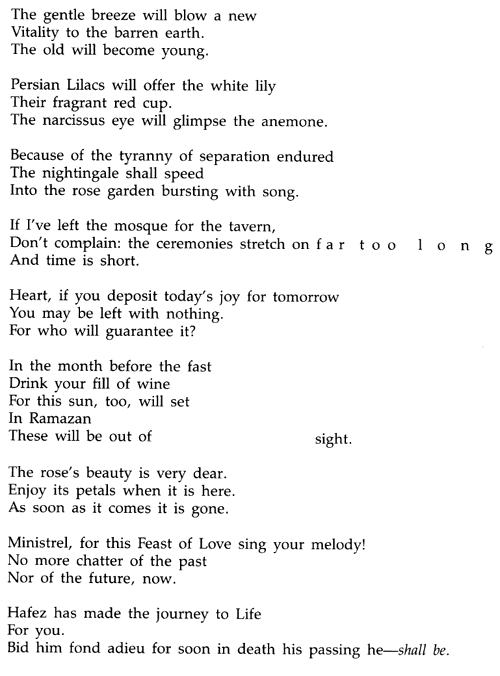

The Day Following Nowruz
(March 20th, 2025)
In our case this year in the United States, nowruz falls very early in the morning. We’ll be doing these rituals the same day. Generally, on this day, all the family gathers at the eldest family member’s house to eat sabzee polõ bā māhi, the traditional nowruz food. You can find a recipe for this amazing dish here. This dish represents the spring harvest with the many delicious fresh herbs and vegetables it contains.
The rest of the day is spent laughing, eating and drinking chāi with family and close friends.

During the 13 Days of Nowruz
The nowruz holiday lasts for 13 days total. Generally, these 13 days are meant to be a break from work and the office, and time to fulfill one of my favorite parts of the nowruz holiday- the tradition of deed ō bāz deed. This literally means ‘to see and see again’. During the 13 days of the beginning of spring, the tradition is to go visit all of your friends and family, and they in turn have to come to your house to see you. Everyone is ready to be a gracious host this week, supplying guests with plenty of sweets (sheereenee) to ring in the new year, and also tea (chāi) and fruit (meevé) of course (what Iranian household doesn’t have a giant bowl of fruit ready at all times?). It’s customary to visit elders of the family first, and then make your way through the list of all close family, friends, and even acquaintances.

13 days after nowruz- seezdah bedar!
(April 2nd, 2025)
Seezdah bedar (literally meaning 'the thirteenth be GONE!') marks the official end of the nowruz holiday, and launches you into a successful start to the coming year.
As in many other cultures, the number 13 is unlucky in the Iranian tradition. Spending it indoors is seen as bad luck, so on this day, Iranian families pack a picnic and spend the entire day outdoors. This year, this holiday falls on Wednesday, April 2nd, 2025. Because this falls in the middle of the workweek in the west, we usually celebrate the holiday the following Sunday (for us here in Austin, that will be on April 6th).
Things to do on seezdah bedar:
- Pack a picnic and plenty of activity and games to spend the entire door outside. Make sure to have a comfortable blanket as well. Many families also set up tents so they can have a quick nap (chort) outside if they get tired.
- Spend the day visiting, laughing, and eating with friends and family. The joy of the day is supposed to ward off an evil that the unlucky number thirteen might bring along with it.
- Knot your wheatgrass with plenty of wishes. Traditionally, unmarried girls (and boys) knot the wheatgrass with wishes of finding a long term partner, but other wishes can be put into the wheatgrass as well. This includes wishes of health and happiness for the coming year.
- Throw the wheatgrass into a moving body of water. This represents sending nature back into nature.
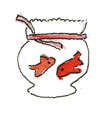
Afterwards
Obviously, this is a lot to do for the nowruz holiday, and there’s no obligation or expectation to get it all done. However, if you are able to even complete a fraction of these activities, you can get a beautiful start to the spring season.
Remember, you never know how many springs you have to enjoy in this lifetime. You might as well enjoy and cherish every single one to the fullest.
Are you planning on participating in this year’s nowruz holiday? Follow me on instagram to let us know how you plan to participate as well!
Thank you and nowruz Mobārak!
